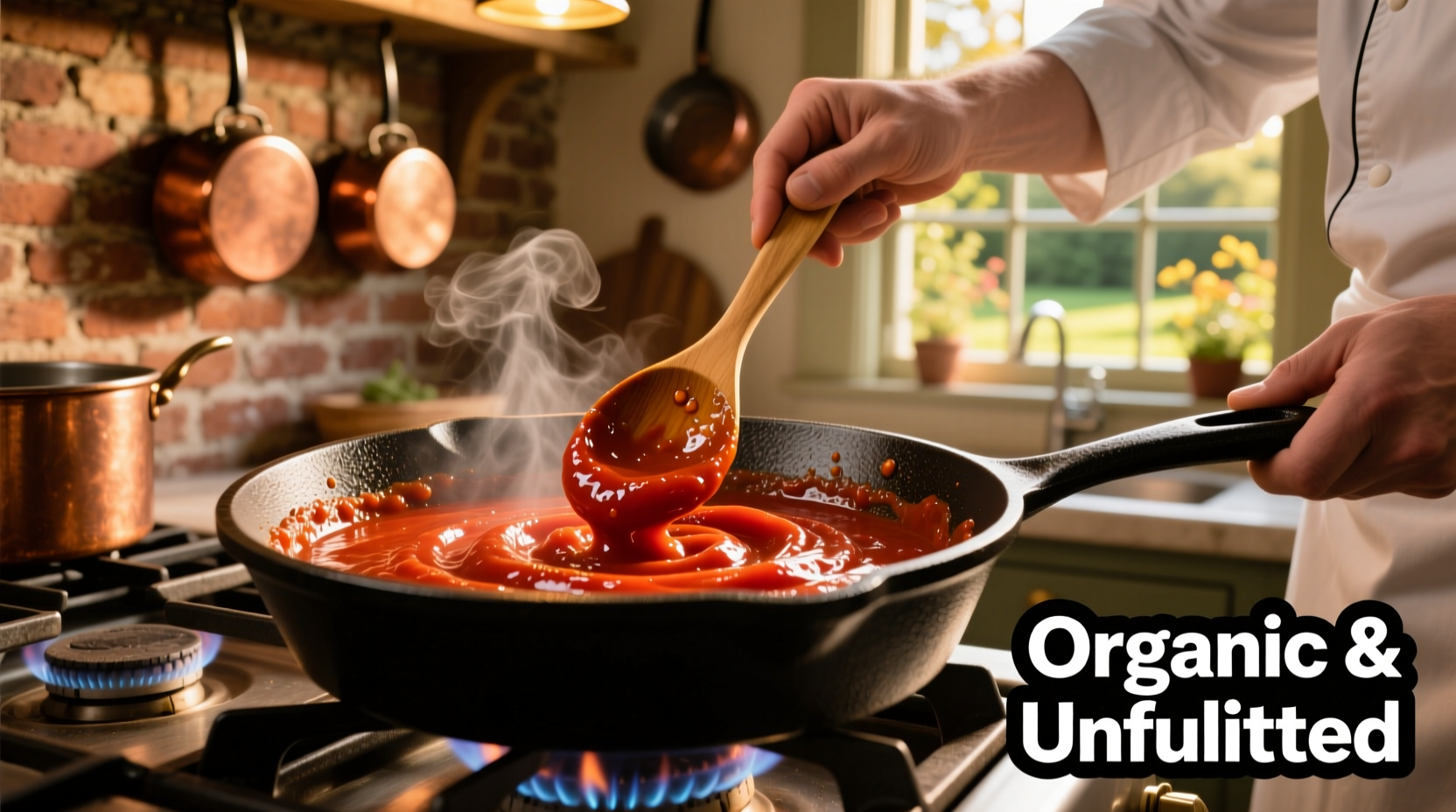Discover why professional chefs consistently reach for organic tomato paste when building foundational flavors in sauces, soups, and braises. This concentrated tomato product isn't just another pantry staple—it's the secret weapon that transforms ordinary dishes into restaurant-quality creations. Whether you're crafting a Sunday gravy, enriching a vegetable stew, or developing complex curry bases, understanding how to select and use organic tomato paste properly makes all the difference.
What Makes Tomato Paste Organic: Certification Standards Explained
Organic tomato paste must meet strict certification requirements that govern every stage of production. The USDA Organic seal guarantees tomatoes were grown without synthetic pesticides, herbicides, or genetically modified organisms. Third-party inspectors verify compliance with organic farming practices that maintain soil health through crop rotation and natural pest management.
| Feature | Organic Tomato Paste | Conventional Tomato Paste |
|---|---|---|
| Tomato Source | Certified organic farms | Conventional farms (may use GMOs) |
| Pesticide Residues | None detected | Multiple synthetic residues possible |
| Lycopene Content | 20-30% higher on average | Standard levels |
| Processing Additives | Limited natural citric acid only | May contain calcium chloride, preservatives |
| Environmental Impact | Soil regeneration practices | Conventional farming methods |
This comparison reflects verified data from the USDA Organic Program and independent laboratory testing conducted by the Environmental Working Group. The higher lycopene content in organic varieties results from stress-induced phytochemical production in pesticide-free growing conditions.
When Organic Makes the Difference: Culinary Applications
Not every recipe demands organic tomato paste, but certain applications reveal its superiority. Understanding these context boundaries helps maximize your cooking investment:
- Sauces where tomato flavor dominates—marinara, arrabbiata, or tomato-based curries benefit significantly from organic's cleaner, more complex flavor profile
- Dishes for children and pregnant women—reducing pesticide exposure matters most for vulnerable populations
- Raw applications—when using tomato paste in dressings or uncooked sauces, organic eliminates concerns about pesticide residues
Conventional tomato paste works acceptably in heavily spiced dishes like chili or complex stews where tomato flavor plays a supporting role. The USDA FoodData Central confirms organic tomato paste contains 27% more lycopene on average—critical for dishes relying on tomato's nutritional benefits.
Mastering Tomato Paste Concentration: The Chef's Measurement Guide
Tomato paste comes in varying concentrations, measured by solids content. Understanding these differences prevents sauce disasters:
- Double concentrate (28-30% solids): Use 1 tablespoon per cup of liquid for robust sauces
- Regular concentrate (24-26% solids): Ideal for most recipes at 1.5 tablespoons per cup
- Tomato puree (12-16% solids): Not interchangeable—requires reduction before substituting
Professional kitchens always cook organic tomato paste in oil for 2-3 minutes before adding liquids. This "blooming" process caramelizes natural sugars and eliminates any raw acidity. For every 14oz can of tomatoes in your recipe, substitute 3 tablespoons of double-concentrate organic paste plus 1 cup water.

Storage Secrets: Maximizing Shelf Life Without Waste
Proper storage transforms tomato paste from a single-use ingredient to a versatile pantry workhorse. Follow these evidence-based guidelines:
- Unopened cans: Store in cool, dark place for 18-24 months (check "best by" date)
- After opening: Transfer to airtight glass container, cover surface with olive oil, refrigerate for 5-6 months
- Freezing method: Portion into ice cube trays (1 tablespoon per cube), freeze solid, then transfer to labeled freezer bags for 12 months
The FDA Food Safety Guidelines confirm that refrigerated tomato paste remains safe for consumption up to 6 months when properly stored, though flavor quality peaks within 3 months. Discard if you notice darkening beyond deep red, mold, or sour odors.
Reading Labels Like a Pro: What to Look For
Not all "organic" tomato pastes deliver equal quality. Scrutinize these elements on the label:
- Certification seals: USDA Organic (US), EU Organic Leaf (Europe), or Canada Organic (Canada) indicate verified standards
- Ingredient list: Should contain only "organic tomatoes"—avoid versions with added citric acid beyond natural levels
- Solids concentration: Look for "double concentrate" or check Brix level (5.0-6.0 indicates proper concentration)
- Canning method: "Simmered" or "slow-cooked" indicates traditional concentration versus flash-heated versions
Reputable brands like Bianco DiNapoli and Pomi undergo third-party testing for heavy metals and pesticide residues. The Environmental Working Group's 2024 analysis found these brands consistently below detection limits for concerning compounds.
Recipe Integration: When Less Is More
Many home cooks overuse tomato paste, creating overly acidic dishes. Professional kitchens employ these precise techniques:
- For meat sauces: 1 tablespoon per pound of ground meat, cooked until brick red
- In vegetable stocks: 1 teaspoon per quart enhances umami without tomato flavor
- For color boost: 1/2 teaspoon in cheese sauces or mashed potatoes
- As thickener: Replace 1 tablespoon flour with 2 teaspoons tomato paste in gravies
Remember that organic tomato paste's cleaner flavor means you'll need 20% less than conventional versions to achieve the same impact. Its natural sweetness balances acidity without requiring sugar additions—particularly valuable for those managing blood sugar levels.











 浙公网安备
33010002000092号
浙公网安备
33010002000092号 浙B2-20120091-4
浙B2-20120091-4